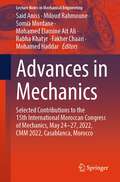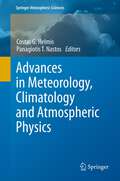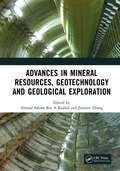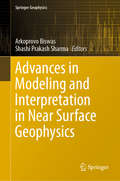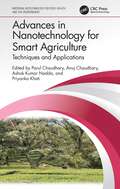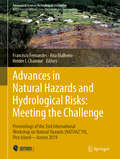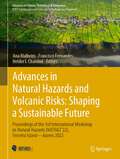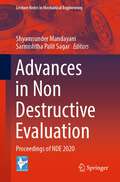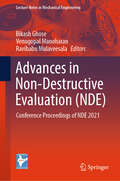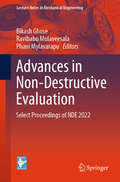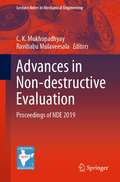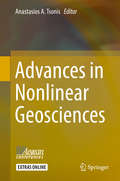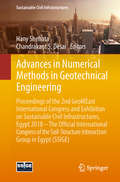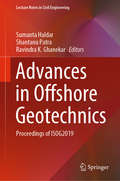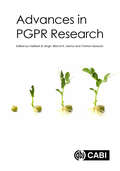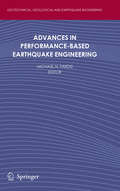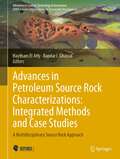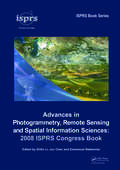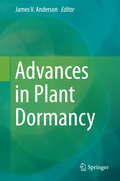- Table View
- List View
Advances in Mechanics: Selected Contributions to the 15th International Moroccan Congress of Mechanics, May 24-27, 2022, CMM 2022, Casablanca, Morocco (Lecture Notes in Mechanical Engineering)
by Fakher Chaari Mohamed Haddar Said Aniss Miloud Rahmoune Somia Mordane Mohamed Elamine Ait Ali Rabha KhatyrThis book reports on innovative research in solid and fluid mechanics, and thermal engineering, giving a special emphasis on methods, modeling, and simulation tools for analyzing material behavior and energy systems. It gathers the best papers presented at 15th International Moroccan Congress of Mechanics "Congrès de Mécanique", CMM 2022, held on May 24-27, 2022, in Casablanca, Morocco, and organized by the Moroccan Society of Mechanics (SMSM) and the Faculty of Science Ain Chock of the University of Hassan II, Casablanca, Morocco. With a good balance of theory and practice, the book offers a timely snapshot of current advances in mechanics, and a source of inspiration for future research and international collaborations.
Advances in Metallacrown Chemistry
by Curtis M. ZaleskiThis volume focuses on recent developments in metallacrown chemistry. While the field was established in 1989 by Professor Vincent Pecoraro and numerous applications had been proposed, there has been a recent surge in the practical applications for this class of molecules. Written by leaders in the metallacrown chemistry field this book addresses recent developments. The single-molecule magnet properties of metallacrowns are presented along with discussions on their ability to bind DNA, as well as their potency to serve as building blocks for supramolecular structures. The volume is not only intended for those who work directly in the field of metallacrowns but it also appeals to those working in the aligned fields of metallamacrocyclic chemistry, self-assembly chemistry, and supramolecular chemistry. This dedicated volume serves as an encyclopedic reference for those wishing to gain insight into the field.
Advances in Meteorology, Climatology and Atmospheric Physics (Springer Atmospheric Sciences)
by Costas G. Helmis Panagiotis T. NastosThis book essentially comprises the proceedings of the 11th International Conference of Meteorology, Climatology and Atmospheric Physics (COMECAP 2012) that is held in Athens from 30 May to 1 June 2012. The Conference addresses researchers, professionals and students interested in the following topics: Agricultural Meteorology and Climatology, Air Quality, Applied Meteorology and Climatology, Applications of Meteorology in the Energy Sector, Atmospheric Physics and Chemistry, Atmospheric Radiation, Atmospheric Boundary Layer, Biometeorology and Bioclimatology, Climate Dynamics, Climatic Changes, Cloud Physics, Dynamic and Synoptic Μeteorology, Extreme Events, Hydrology and Hydrometeorology, Mesoscale Meteorology, Micrometeorology/Urban Microclimate, Remote Sensing/ Satellite Meteorology and Climatology, Weather Analysis and Forecasting. The book includes all papers that have been accepted for presentation at the conference.
Advances in Mineral Resources, Geotechnology and Geological Exploration: Proceedings of the 7th International Conference on Mineral Resources, Geotechnology and Geological Exploration (MRGGE 2022), Xining, China, 18-20 March, 2022
by Junwen Zhang Rashid, Ahmad Safuan Bin AAdvances in Mineral Resources, Geotechnology and Geological Exploration focuses on the research of mineral resources, geotechnology and geological exploration. The proceedings features the most cutting-edge research directions and achievements related to geology. Subjects in this proceedings include: · Materials of geography · Resource exploration · Geotechnical engineering · Rock mechanics and rock engineering The works of this proceedings can promote development of geology, resource sharing, flexibility and high efficiency. Thereby, promote scientific information interchange between scholars from top universities, research centers and high-tech enterprises working all around the world.
Advances in Minerals Research (Advances in Material Research and Technology)
by Shadia Jamil IkhmayiesThis book offers background material, reviews, and researched findings into the realms of minerals, mining, metallurgy, and engineering. Firstly, it elucidates fundamental mineral concepts, mining techniques, and mineral processing methods; secondly, it unveils cutting-edge insights on fine and coarse particle flotation, unveiling breakthrough technologies for enhanced efficiency; and thirdly, it explores the innovative applications of ultrasound and thermoluminescence in mineral processing, offering a holistic view of the latest advancements. This book sheds light on the versatile uses of silicones, the intricacies of bentonite clay, and the production pathways, properties, and applications of hydroxyapatite. Furthermore, the book provides invaluable insights into biomimetic biomineralization, the synthesis of low-carbon bio-cements, and the pioneering strides in mineral-based phase change materials.
Advances in Mobile Mapping Technology (Isprs Book Ser. #4)
by Jonathan Li C. Vincent TaoThe growing market penetration of Internet mapping, satellite imaging and personal navigation has opened up great research and business opportunities to geospatial communities. Multi-platform and multi-sensor integrated mapping technology has clearly established a trend towards fast geospatial data acquisition. Sensors can be mounted on various pla
Advances in Modeling and Interpretation in Near Surface Geophysics (Springer Geophysics)
by Arkoprovo Biswas Shashi Prakash SharmaThis book deals primarily with the aspects of advances in near surface geophysical data modeling, different interpretation techniques, new ideas and an integrated study to delineate the subsurface structures. It also involves the practical application of different geophysical methods to delineate the subsurface structures associated with mineral, groundwater exploration, subsurface contamination, hot springs, coal fire etc. This book is specifically aimed with the state-of-art information regarding research advances and new developments in these areas of study, coupled to extensive modeling and field investigations obtained from around the world. It is extremely enlightening for the research workers, scientists, faculty members and students, in Applied Geophysics, Near Surface Geophysics, Potential Field, Electrical and Electromagnetic Methods, Mathematical Modeling Techniques in Earth Sciences, as well as Environmental Geophysics.
Advances in Nanotechnology for Smart Agriculture: Techniques and Applications (Microbial Biotechnology for Food, Health, and the Environment)
by Parul ChaudharyThe yield of major agricultural crops can be severely decreased due to the inappropriate application of commonly used harmful chemicals. Excessive agrochemicals in field application can negatively affect microbial populations and their diversity, which in turn ultimately affects plant growth. Thus, it is necessary to turn toward more eco-friendly approaches which equally protect crops as well as the desirable microbial populations of complex soil systems. Nanoparticles are considered as potential agents for the production and development of sustainable agriculture. Green synthesis of nanoparticles has gained attention as a useful measure to diminish the harmful effects associated with the old methods of nanoparticle synthesis. Advances in Nanotechnology for Smart Agriculture: Techniques and Applications illustrates the science and practical applications of nanoparticles for sustainable agriculture. Features: Examines the role of nanotechnology in agricultural best practices, including sustainable development, precision farming, and long-term soil health
Advances in Natural Hazards and Hydrological Risks: Proceedings of the 2nd International Workshop on Natural Hazards (NATHAZ'19), Pico Island—Azores 2019 (Advances in Science, Technology & Innovation)
by Helder I. Chaminé Francisco Fernandes Ana MalheiroThis book gathers the proceedings of the 2nd International Workshop on Natural Hazards (NATHAZ'19), held in Lajes do Pico, Pico Island, Azores in 2019. Natural hazards constitute the threat of a naturally occurring event having a negative effect on human beings. These effects are often called natural disasters. Among the natural hazards and potential disasters to be considered are: earthquakes, volcanic eruptions, landslides, subsidence, floods, droughts and coastal erosion. In addition, there are anthropogenic hazards that occur as a result of human interactions with the environment. They include technological hazards, which occur due to exposure to hazardous substances in the environment. Grasping the behaviour of natural systems requires a comprehensive understanding of climatology, geology and hydrology data and dynamics. Thus, it is important to conduct hazard and risk assessment studies for meaningful hazard mitigation. Further, the book demonstrates that an accurate understanding of natural systems and interactions between engineering and natural resources is of vital significance to the entire socio-economic sector. This volume offers an overview of natural hazards in model regions in Europe, America, and Atlantic islands. Providing new insights on the characterisation, assessment, protection and modelling of geological hazards, water systems, urban areas and coastal zones, it represents a valuable resource for all researchers and practitioners in the fields of Geosciences, Hydrology, Water Resources, Natural Hazards, Environments and Engineering. Main topics include:1. Natural Hazards and Disasters2. Sustainable Water Systems and Climate Change3. Technological Hazards and Engineering Design
Advances in Natural Hazards and Volcanic Risks: Proceedings of the 3rd International Workshop on Natural Hazards (NATHAZ’22), Terceira Island—Azores 2022 (Advances in Science, Technology & Innovation)
by Helder I. Chaminé Francisco Fernandes Ana MalheiroThis book comprises the selected proceedings of the 3rd International Workshop on Natural Hazards (NATHAZ’22), Angra do Heroísmo, Terceira Island, Azores, 2022. The book interests all researchers and practitioners in Earth Sciences, Volcanic Risks, Natural Hazards, Geoethics, Environmental Sciences and Engineering. Terceira is a volcanic island with volcanic systems with caldera (Cinco Picos, Guilherme Moniz, Santa Bárbara and Pico Alto central volcanoes) and an active fissural zone defined by various alignments of small volcanic cones, lava domes and fault zones. The agricultural landscape, the natural and forest reserve, as well as the natural pools make the island a unique place to visit. The historic downtown of Angra do Heroísmo is a UNESCO world heritage, and several iconic buildings witness the island’s geodynamic history. Natural hazards result from a threat of a naturally occurring event that will have a negative effect on humans. That damaging effect is often called natural disasters. Among the natural hazards and potential disasters to be considered are: earthquakes, volcanic eruptions, landslides, subsidence, floods, droughts and coastal erosion. In addition, anthropogenic hazards occur as a result of human interaction with the environment. They comprise technological risks due to exposure to hazardous substances in the environment. Natural systems in different frameworks require a comprehensive understanding of climatology, geology, hydrology and volcanic data, processes and dynamics. Thus, it is important to perform hazard and risk assessment studies to accomplish hazard mitigation. In addition, it highlighted the role of variability and climate change in Earth systems. Furthermore, an accurate understanding of the natural systems and interactions with engineering, geodiversity and natural resources is vital to the entire socioeconomic sector. This book is expected to offer an overview of natural hazards in model regions in Europe, America, Asia and the Atlantic islands. It gives new insights into the characterization, assessment, protection, and modelling of geological hazards, volcanic systems, urban areas, coastal zones and engineering approaches by international researchers and professionals. The scientific committee comprises lead geoscientists, natural hazards related practitioners, and academics worldwide. The main topics include: 1. Multi-hazards and risks: sustainable society, disasters and geoethics 2. Natural hazards and assessment: rock falls, landslides, urban planning and management 3. Sustainable Earth systems: hazards and climate change 4. Terceira Island geology and geodiversity: meeting volcanological hazards in the Azores
Advances in Non Destructive Evaluation: Proceedings of NDE 2020 (Lecture Notes in Mechanical Engineering)
by Shyamsunder Mandayam Sarmishtha Palit SagarThis book comprises the proceedings of the Conference and Exhibition on Non Destructive Evaluation (NDE 2020). The contents of the volume encompass a vast spectrum from Conventional to Advanced NDE including novel methods, instrumentation, sensors, procedures, and data analytics as applied to all industry segments for quality control, periodic maintenance, life estimation, structural integrity and related areas. This book will be a useful reference for students, researchers and practitioners.
Advances in Non-Destructive Evaluation: Conference Proceedings of NDE 2021 (Lecture Notes in Mechanical Engineering)
by Ravibabu Mulaveesala Bikash Ghose Venugopal ManoharanThis book comprises the proceedings of the Conference and Exhibition on Non-Destructive Evaluation (NDE 2021) organised by the Indian Society for Non-destructive Testing (ISNT). This book covers topics from wide domains from conventional to advanced NDE, including conventional and advanced NDE methods, drone-based inspections, thermal wave imaging, NDT data fusion, material characterization, waveguide sensors, inspections of civil structures, medical applications such as bone density and cancer diagnosis, periodic maintenance, life estimation, as well as structural integrity and related areas. This book serves as a useful reference for students, researchers, and practitioners alike.
Advances in Non-Destructive Evaluation: Select Proceedings of NDE 2022 (Lecture Notes in Mechanical Engineering)
by Ravibabu Mulaveesala Bikash Ghose Phani MylavarapuThis book comprises the proceedings of the Conference and Exhibition on Non-Destructive Evaluation (NDE 2022). The contents of the volume encompass a vast spectrum from conventional to advanced NDE including novel methods, and emerging NDE technologies. It covers topics from wide domains from conventional to advanced NDE methods which includes but not limited to drone-based inspections, thermal wave imaging, microwave NDE, shearography, Quantitative NDE using Digital Image Correlation, modeling and simulation, NDT data fusion, material characterization, waveguide sensors, inspections of civil structures, medical applications such as bone density and cancer diagnosis, signal and image processing, NDE sensors, instrumentation, software and systems, NDE 4.0 and robotics, automation, AI in NDE, functional and operational testing, NDE data analytics, reliability and safety assurance, periodic maintenance, life estimation, as well as structural integrity and related areas. This book serves as a useful reference for students, researchers, and practitioners working in the areas of non-destructive testing and evaluation.
Advances in Non-destructive Evaluation: Proceedings of NDE 2019 (Lecture Notes in Mechanical Engineering)
by C. K. Mukhopadhyay Ravibabu MulaveesalaThis book comprises the proceedings of the Conference and Exhibition on Non Destructive Evaluation, (NDE 2019). The contents of the book encompass a vast spectrum from Conventional to Advanced NDE including novel methods, instrumentation, sensors, procedures and data analytics as applied to all industry segments for quality control, periodic maintenance, life estimation, structural integrity and related areas. This book will be a useful reference for students, researchers and practitioners.
Advances in Nonlinear Geosciences
by Anastasios A. TsonisAdvances in Nonlinear Geosciences is a set of contributions from the participants of "30 Years of Nonlinear Dynamics" held July 3-8, 2016 in Rhodes, Greece as part of the Aegean Conferences, as well as from several other experts in the field who could not attend the meeting. The volume brings together up-to-date research from the atmospheric sciences, hydrology, geology, and other areas of geosciences and presents the new advances made in the last 10 years. Topics include chaos synchronization, topological data analysis, new insights on fractals, multifractals and stochasticity, climate dynamics, extreme events, complexity, and causality, among other topics.
Advances in Nuclear Physics: Structure and Reactions (Springer Proceedings in Physics #257)
by Rohit Kumar Rajeev K. Puri Joerg Aichelin Sakshi GautamThis volume comprises select peer-reviewed papers from the Indo-French Workshop on Multifragmentation, Collective Flow, and Sub-Threshold Particle Production in Heavy-Ion Reactions held at the Department of Physics, Panjab University, Chandigarh, India in February, 2019. The contents highlight latest research trends in intermediate energy nuclear physics and emphasize on the various reaction mechanisms which take place in heavy-ion collisions. The chapters contribute to the understanding of interactions that govern the dynamics at sub-nucleonic level. The book includes contributions from global experts hailing from major research facilities of nuclear physics, and provides a good balance between experimental and theoretical model based studies. Given the range of topics covered, this book can be a useful reference for students and researchers interested in the field of heavy-ion reactions.
Advances in Numerical Methods in Geotechnical Engineering: Proceedings of the 2nd GeoMEast International Congress and Exhibition on Sustainable Civil Infrastructures, Egypt 2018 – The Official International Congress of the Soil-Structure Interaction Group in Egypt (SSIGE) (Sustainable Civil Infrastructures)
by Hany Shehata Chandrakant S. DesaiThis volume deals with numerical simulation of coupled problems in soil mechanics and foundations. It contains analysis of both shallow and deep foundations. Several nonlinear problems are considered including, soil plasticity, cracking, reaching the soil bearing capacity, creep, etc. Dynamic analyses together with stability analysis are also included. Several numerical models of dams are considered together with coupled problems in soil mechanics and foundations. It gives wide range of modeling soil in different parts of the world. The volume is based on the best contributions to the 2nd GeoMEast International Congress and Exhibition on Sustainable Civil Infrastructures, Egypt 2018 – The official international congress of the Soil-Structure Interaction Group in Egypt (SSIGE).
Advances in Numerical Simulation in Physics and Engineering: Lecture Notes of the XV 'Jacques-Louis Lions' Spanish-French School (SEMA SIMAI Springer Series #3)
by Carlos Vázquez Carlos Parés Frédéric CoquelThe book is mainly addressed to young graduate students in engineering and natural sciences who start to face numerical simulation, either at a research level or in the field of industrial applications. The main subjects covered are: Biomechanics, Stochastic Calculus, Geophysical flow simulation and Shock-Capturing numerical methods for Hyperbolic Systems of Partial Differential Equations. The book can also be useful to researchers or even technicians working at an industrial environment, who are interested in the state-of-the-art numerical techniques in these fields. Moreover, it gives an overview of the research developed at the French and Spanish universities and in some European scientific institutions. This book can be also useful as a textbook at master courses in Mathematics, Physics or Engineering.
Advances in Offshore Geotechnics: Proceedings of ISOG2019 (Lecture Notes in Civil Engineering #92)
by Sumanta Haldar Shantanu Patra Ravindra K. GhanekarThis book comprises select proceedings of the First Indian Symposium on Offshore Geotechnics. It addresses state of the art and emerging challenges in offshore design and construction. The theme papers from leading academicians and practitioners provide a comprehensive overview of the broad topics encompassing various challenges in offshore geotechnical engineering. It covers various aspects pertaining to offshore geotechnics, such as offshore site investigation, soil characterization, geotechnics related to offshore renewable energy converters, offshore foundations and anchoring systems, pipelines, and deep sea explorations. This volume provides a comprehensive reference for professionals and researchers in offshore, civil and maritime engineering and for soil mechanics specialists.
Advances in PGPR Research
by Virendra S. Bisaria Randy Ortiz-Castro Robert Hill Jose López-Bucio Madhu Kamle Pradeep Kumar Dubey Rama Kant Dubey Kartikay Bisen Dr Chetan Keswani P. C. Abhilash Betina Cecilia Agaras Gautam Anand Laith K. Al-Ani Fabiola Padilla Arizmendi Fatima Berenice Salazar-Badillo Mansi Bakshi E. J. Bedmar Adrien Biessy Marieta Marin Bruzos Jesús Salvador López-Bucio Jorge Armando Mauricio-Castillo Vasvi Chaudhry Niladri Chaudhry Manoj Kumar Chitara Pooja Choudhary Manish Kumar Dubey Sheikh Adil Edirisi Martin Filion Elisabetta Franchi Deepika Goyal Natalia Cripps-Guazzone Antonio Castellano-Hinojosa Angela Cristina Ikeda María Fernanda Nieto-Jacobo Diwakar Kandula Gagan Kumar Punam Kumari Richard Daniel Lally Robert Lawry Guillermo Nogueira-López Anupam Maharshi Shrikant S. Mantri Rafael Jorge Marcillo Dmitri V. MavrodiRhizosphere biology is approaching a century of investigations wherein growth-promoting rhizomicroorganisms (PGPR) have attracted special attention for their ability to enhance productivity, profitability and sustainability at a time when food security and rural livelihood are a key priority. Bio-inputs - either directly in the form of microbes or their by-products - are gaining tremendous momentum and harnessing the potential of agriculturally important microorganisms could help in providing low-cost and environmentally safe technologies to farmers.One approach to such biologically-based strategies is the use of naturally occurring products such as PGPR. Advances in PGPR Research explores recent developments and global issues in biopesticide research, presented via extended case studies and up-to-date coverage of: · Low input biofertilizers and biofungicides used for sustainable agriculture. · Molecular techniques to enhance efficacy of microbial inputs. · Intellectual property issues in PGPR research. Written by an international team of experts, this book considers new concepts and global issues in biopesticide research and evaluates the implications for sustainable productivity. It is an invaluable resource for researchers in applied agricultural biotechnology, microbiology and soil science, and also for industry personnel in these areas.
Advances in Performance-Based Earthquake Engineering (Geotechnical, Geological and Earthquake Engineering #13)
by Michael N. FardisPerformance-based Earthquake Engineering has emerged before the turn of the century as the most important development in the field of Earthquake Engineering during the last three decades. It has since then started penetrating codes and standards on seismic assessment and retrofitting and making headway towards seismic design standards for new structures as well. The US have been a leader in Performance-based Earthquake Engineering, but also Europe is a major contributor. Two Workshops on Performance-based Earthquake Engineering, held in Bled (Slovenia) in 1997 and 2004 are considered as milestones. The ACES Workshop in Corfu (Greece) of July 2009 builds on them, attracting as contributors world-leaders in Performance-based Earthquake Engineering from North America, Europe and the Pacific rim (Japan, New Zealand, Taiwan, China). It covers the entire scope of Performance-based Earthquake Engineering: Ground motions for performance-based earthquake engineering; Methodologies for Performance-based seismic design and retrofitting; Implementation of Performance-based seismic design and retrofitting; and Advanced seismic testing for performance-based earthquake engineering. Audience: This volume will be of interest to scientists and advanced practitioners in structural earthquake engineering, geotechnical earthquake engineering, engineering seismology, and experimental dynamics.
Advances in Peridynamics
by Erdogan Madenci Pranesh Roy Deepak BeheraThis book presents recent improvements in peridynamic modeling of structures. It provides sufficient theory and numerical implementation helpful to both new and existing researchers in the field. The main focus of the book is on the non-ordinary state-based (NOSB) peridynamics (PD) and its applications for performing finite deformation. It presents the framework for modeling high stretch polymers, viscoelastic materials, thermoelasticity, plasticity, and creep. It provides a systematic derivation for dimensionally reduced structures such as axisymmetric structures and beams. Also, it presents a novel approach to impose boundary conditions without suffering from displacement kinks near the boundary. Furthermore, it presents refinements to bond-based PD model by including rotation kinematics for modeling isotropic and composite materials. Moreover, it presents a PD – FEM coupling framework in ANSYS based on principle for virtual work. Lastly, it presents an application of neural networks in the peridynamic (PINN) framework. Sample codes are provided for readers to develop hands-on experience on peridynamic modeling. Describes new developments in peridynamics and their applications in the presence of material and geometric nonlinearity; Describes an approach to seamlessly couple PD with FE; Introduces the use of the neural network in the PD framework to solve engineering problems;Provides theory and numerical examples for researchers and students to self-study and apply in their research (Codes are provided as supplementary material);Provides theoretical development and numerical examples suitable for graduate courses.
Advances in Petroleum Source Rock Characterizations: A Multidisciplinary Source Rock Approach (Advances in Science, Technology & Innovation)
by Haytham El Atfy Bandar I. GhassalThis book is directed to those who are interested in petroleum geology, especially source rock from both academia and industrial societies. Our chapter-based book is written by a list of world-class subject-matter experts.The book includes recent advancements in analytical source rock characterization methods with some case studies. It is also used as part of a course curriculum or guide for source rock interpretation for all researcher categories.Significant improvement in the source rock characterization techniques in the last two decades and the knowledge is disseminated in a huge amount of papers and studies. The book intends to collect these recent advancements in one textbook to benefit students and researchers in general. In addition, it is supplemented by many case studies from all over the world that represent important data sets for the regional geology of these areas.
Advances in Photogrammetry, Remote Sensing and Spatial Information Sciences: 2008 ISPRS Congress Book (ISPRS Book Series)
by Jun Chen Zhilin Li Emmanuel BaltsaviasPublished on the occasion of the XXIst Congress of the International Society for Photogrammetry and Remote Sensing (ISPRS) in Beiijng, China in 2008, Advances in Photogrammetry, Remote Sensing and Spatial Information Sciences: 2008 ISPRS Congress Book is a compilation of 34 contributions from 62 researchers active within the ISPRS. The book covers
Advances in Plant Dormancy
by James V. AndersonPlant dormancy involves synchronization of environmental cues with developmental processes to ensure plant survival; however, negative impacts of plant dormancy include pre-harvest sprouting, non-uniform germination of crop and weed seeds, and fruit loss due to inappropriate bud break. Thus, our continued quest to disseminate information is important in moving our understanding of plant dormancy forward and to develop new ideas for improving food, feed, and fiber production and efficient weed control, particularly under global climate change. Proceeding from the 5th International Plant Dormancy Symposium will provide an overview related on our current understanding of how environmental factors impact cellular, molecular, and physiological processes involved in bud and seed dormancy, and perspectives and/or reviews on achievements, which should stimulate new ideas and lines of investigation that increase our understanding of plant dormancy and highlight directions for future research.
